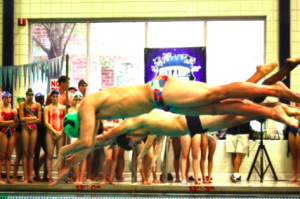By: Jayme Deerwester, FitterandFaster.com
When it comes to putting a fright into swimmers, zombies and ghosts have nothing on these terrors:
 1. Your first 200 fly or 400 IM race. Practicing the two most feared events in swimming is one thing; waiting behind the blocks knowing you are about to race one is another animal entirely. You may be able to delay the inevitable, (“Coach, I was in the bathroom and didn’t hear them call my heat!”) but you can’t outrun them forever. Might as well give it your best because you will remember this race for the rest of your life.
1. Your first 200 fly or 400 IM race. Practicing the two most feared events in swimming is one thing; waiting behind the blocks knowing you are about to race one is another animal entirely. You may be able to delay the inevitable, (“Coach, I was in the bathroom and didn’t hear them call my heat!”) but you can’t outrun them forever. Might as well give it your best because you will remember this race for the rest of your life.
2. Suffering a goggle malfunction during a race. Goggle mishaps don’t discriminate – just ask Kevin Cordes, who lost his during a PanPac final this summer, or Michael Phelps, who swam an Olympic 200 fly final blind after his filled with water. Phelps still won gold in that race because he practiced maintaining a specific stroke count and could count on that even when he couldn’t see. Know when you can safely remove your goggles (after a legal wall touch on fly or breast; you might be able to do it mid-stroke on free or back as long as it doesn’t disrupt the stroke and you don’t touch the bottom). And there’s nothing stopping you from rehearsing for a goggle malfunction. Practice swimming with your goggles full of water. Get comfortable being uncomfortable.
 3. Forgetting your breakfast or lunch after morning practice. Kids are lucky today – many schools offer prepaid cafeteria accounts so you never have to remember to bring cash. (We weren’t so fortunate back in the day.) But what if you packed your meal and left it in your parent’s car (and s/he went to work or across town to see your grandma)? Rather than starve, ask the cafeteria manager if you can do an IOU that day and pay the next. (Note to self: Stash an emergency $5 bill or a box of melt-resistant energy bars in your locker for next time. There will probably be a next time.)
3. Forgetting your breakfast or lunch after morning practice. Kids are lucky today – many schools offer prepaid cafeteria accounts so you never have to remember to bring cash. (We weren’t so fortunate back in the day.) But what if you packed your meal and left it in your parent’s car (and s/he went to work or across town to see your grandma)? Rather than starve, ask the cafeteria manager if you can do an IOU that day and pay the next. (Note to self: Stash an emergency $5 bill or a box of melt-resistant energy bars in your locker for next time. There will probably be a next time.)
4. Your coach tells you to bring running shoes to practice – but not for dryland.Something wicked this way comes and it’s called a drag set. Even good kickers can struggle to go anywhere with sneakers on their feet. You lose the feel of the water on the up and down-kick. The upside: When you take them off, you’ll feel like you’re wearing fins. It’s similar to the sensation you feel when you get to use your hand again after doing fist drill. You develop a whole new appreciation for your feel for the water.
 5. Forgetting your suit, goggles, towel, after-practice clothes and so on.We’ve all done it. Last year, I had to walk around the office in flip-flops one day because I only packed one shoe. This is a good reminder why it’s smart to pack your bag the night before. But you can also build redundancy into the system. Keep an extra pair of goggles and cap in your bag. If you drive yourself to practice, keep back-ups in your car. If your team practices at a gym that provides towels, take advantage of that. Maybe even keep a swimmer’s chamois in your bag as a back-up. They don’t take up much room and they’re better than paper towels or putting clothes on wet skin.
5. Forgetting your suit, goggles, towel, after-practice clothes and so on.We’ve all done it. Last year, I had to walk around the office in flip-flops one day because I only packed one shoe. This is a good reminder why it’s smart to pack your bag the night before. But you can also build redundancy into the system. Keep an extra pair of goggles and cap in your bag. If you drive yourself to practice, keep back-ups in your car. If your team practices at a gym that provides towels, take advantage of that. Maybe even keep a swimmer’s chamois in your bag as a back-up. They don’t take up much room and they’re better than paper towels or putting clothes on wet skin.
6. Missing the wall. You had a great start, a smooth breakout and a solid first length. Then you flipped and your stomach dropped when you realized the wall wasn’t as close as you thought it was. You’re lucky your toe touched the wall so you didn’t get DQ’d. Again, this is something you can cope with if you prepare well. During meet warm-up, count your strokes in from the flags – at both ends. The distance may be the same but the lighting may not be and that can mess with your depth perception. If you’ve never been to a particular pool before, bring a pair of light or clear goggles. During regular practice, do sets where you leave from the middle of the pool. Or try sets where you push off from the wall and do a mid-pool flip before resuming. Both approaches will teach you to generate a forceful kick that will help get you back up to speed after a botched turn.

7. Hearing the words “for time” come out of your coach’s mouth. For those of us who tend to enjoy practice more than meets, those two words are about the most chilling thing ever to be written on a dry-erase board (with the possible exception of algebra symbols, which mean you’re about to do sets within sets within sets.) To be honest, I still cringe when the words “for time” are attached to a set. But I also realize there are important reasons for doing a timed rep. A swimmer’s technique tends to differ between drudge mode and sprinting – especially the kick, which can change your bodyline and stroke count. You need to experience speed on a regular basis so you can learn to harness it. And the way you learn how to find another gear in a race is by finding it in practice. (This lesson is especially important for Masters swimmers, who often trained long and slow back in the Stone Age and may revert to drudge gear when a set starts to hurt.)







